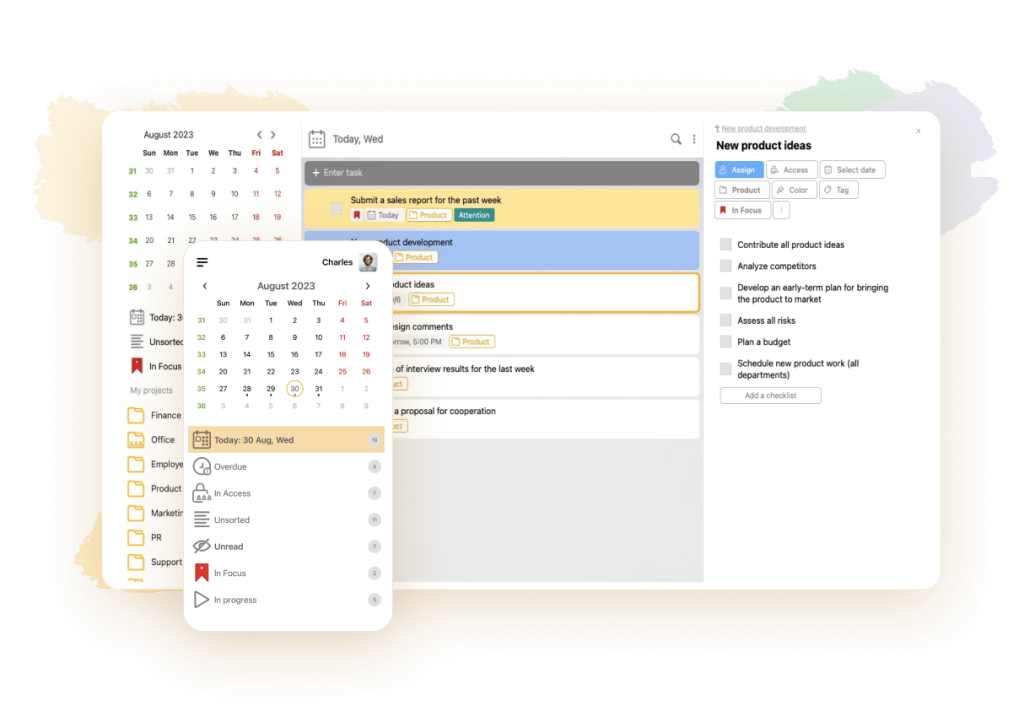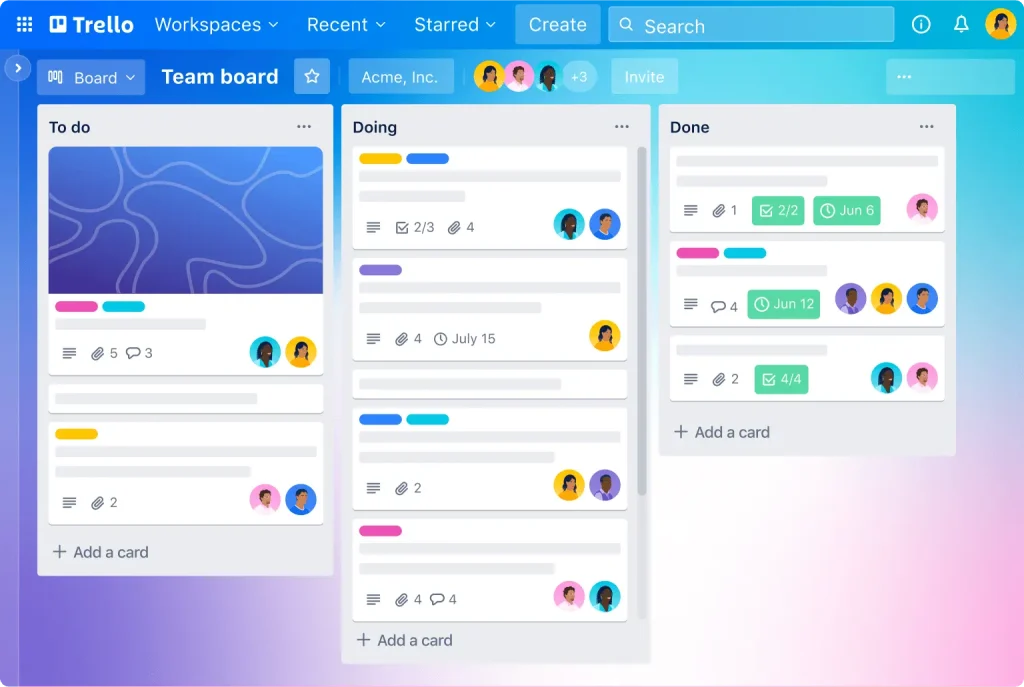Project management fundamentals: models and technologies

To quickly adapt to constantly changing market conditions, 21st century companies resort to various methods and means. One of them is the project approach. In this process, some people play the role of executor, while others lead a team that performs certain functions on the way to a common goal. Project management is used by private entrepreneurs and large companies, international corporations, public institutions in the field of science and education, as well as authorities. What explains such demand? Let’s try to understand.
What is project management
The activities of any company can be divided into projects. The purpose of design is to obtain a meaningful result in the form of a new product, development or service to be launched on the market.
Project management is the organization of work to achieve the planned result within the approved time and budget. Applying efforts, experience, tools to meet the requirements set by the customer.
The scale, features and complexity of the goal will determine how the process is managed. A marketing campaign or the launch of a new software product will use a different methodology.
Just as there are no identical projects, there are no “one-size-fits-all” project organization systems. Each methodology, be it agile or scrum, works in certain conditions and circumstances. Suffice it to recall the experience of the American astronauts who landed on the moon on July 20, 1969. Neil Armstrong’s name instantly became famous. But in fact, the full-scale project owes its success to 400,000 NASA employees and more than 20,000 universities and companies that participated in the Apollo mission.
Project management is distinguished from traditional management by its focus on a specific result. Let’s take a look at the differences between these methods:
| Traditional methodology | Project management |
| Focuses on the process of getting the job done | Result-oriented |
| No time limit | A specific deadline has been set |
| Duties are allocated by position | Resource allocation takes place |
| Monotonous, routine nature of work | Performing tasks of various specifics |
| Work is allocated to permanent employees by position | The work is performed by highly specialized specialists with in-depth knowledge in the required field |
Project management helps to accurately control work processes by dividing them into separate parts. It simplifies budget estimation, ensures compliance with deadlines, and checks the quality of tasks performed by executors at each stage.
The organization of work begins with setting goals, under which a team of specialists with the right skills is selected. They are oriented on standards – rules that must be observed to achieve the result. They are:
- public, developed, used in specialized communities;
- corporate, operating within the same company;
- private, approved.
There are international standards in different countries, the best known of which is PMBOK (A Guide to the Project Management Body of Knowledge), with terms, basic concepts of the approach used in more than 160 countries.
What a project manager should be able to do
When the goal is set and approved, it is time to appoint a project manager. This is the person responsible for the fulfillment of the tasks set. He or she draws up a plan, recruits a team, monitors the progress of work, adherence to deadlines, and rational budget spending. There can be several managers depending on the complexity of the project.
A skilled manager is not someone who makes sure that the project and work is done within the ToR, but a person who can detect a problem in time, communicate to managers how to do the job right.
Performing the functions of a project manager requires competence, theoretical, practical knowledge in the field of entrepreneurial skills, forming a leader capable of thinking strategically, making realistic forecasts and plans. A qualified project manager should be:
- Experienced. To quickly solve business problems at any stage of achieving a goal.
- Technically equipped. The profession implies a clear understanding of the business processes he will be managing. He must understand the essence, the technical subtleties, be it construction, industry or it.
- Able to work within a team.
Responsibility, resistance to stress, communication skills, and analytical thinking are also important for managers. It is hard to find a good project manager in {year}, but you can, for example, look at current trends or media in the field of marketing and learn how to self-manage or try a new profession for yourself.
Fundamentals of project management
A set of certain actions performed within the framework of the set tasks is the foundation of project management. Their number, complexity, terms of execution depend on the specifics of the project. It has several stages of development forming the life cycle:
- Initiation. Define the goal, appoint a leader, make a preliminary calculation of the budget, necessary resources.
- Planning. Develop a strategic action plan for the manager and the team that can adapt to possible changes in the course of the work. At this stage, economics are developed and possible risks are calculated.
- Execution. Each performer performs his/her part of the work. The leader sets assignments, motivates his team members, clearly communicates the essence of the task to each performer.
- Monitoring, control. This task is greatly simplified by the use of CRM-systems that visually display the effectiveness of the implemented measures.
- Completion. It implies execution of documents, transfer of the completed work to the customer. You should not forget about feedback. By taking into account critical comments and making appropriate conclusions, you can avoid many mistakes when implementing new projects.
In project life cycle management, several approaches are used that influence the future performance and success of projects. The following models are used in project management:
| Predictive | Timeline, budget are approved at the preparation stage and remain unchanged throughout. To make changes it is necessary to restructure the whole built system. Suitable for product-specific processes. |
| Iterative-incremental | The project is broken down into individual operations that are repeated as long as necessary to achieve a certain result. The processes are continuously improved. |
| Flexible | For processes that require rapid response to change. Combines iterative and incremental methods |
The easiest way to implement any case within a team or office is to break it down into steps. All it takes is a simple checklist describing the sequence of actions that need to be taken to achieve a specific result.
Projects of different nature, content, and complexity require different degrees of control and organization. A variety of management methodologies are used in their execution.
Popular project management methods and models
This term refers not just to recommendations, methodologies or techniques to be followed in implementing the plan, but to specific actions that set the course of action. These include:
1. Agile
A popular iterative and incremental method based on the formation of requirements and their realization through the interaction of teams of specialists from different profiles. To put it simply, agile is a set of flexible methods that allows you to get a high quality product due to constant contact between performers and customers. Agile method is used in IT-industry, in small companies implementing creative projects.
Key principles of the Agile approach:
- Team relationships are more important than the technical component.
- Software is needed more than documentation.
- Customer interaction is at the forefront.
- Making adjustments at any stage.
Strengths:
- Flexibility, the ability to adjust to the interests of any client.
- Quick startup, increased security.
- Obtaining a quality product ready for use (MVP) Minimum Viable Product.
Weaknesses:
- The need for ongoing customer involvement.
- Lack of understanding of the end result in the early stages.
- Need for highly qualified specialists with appropriate motivation.
2. Scrum
This method is part of the Agile methodology, which is focused on customer needs. The Agile framework is the most structured among other representatives of the family, which includes sets of practices for enterprises and companies of different specifics.
The method starts by dividing the product into separate time periods, sprints, principles within which separate parts of the product, called product backlogs, are created and submitted to the customer representative for evaluation. After receiving feedback, the team makes the necessary adjustments. It is focused on “quick wins” projects that can change in an operational mode.
Pros of the methodology:
- Suitable for teams where not all participants have the necessary competence or experience. Constant interaction between team members compensates for this deficiency by providing timely assistance from colleagues in difficult situations.
- Quickly updated results make processes easy to follow, correcting as needed.
Weaknesses:
- Demanding to the team, the number of its members, their “usefulness”, functionality. They should be competent in several areas to substitute each other if necessary.
- Team members must have self-organization skills and not be afraid to take responsibility.
Scrum methodology is not applicable to all organizations. It can’t always be used to realize a certain product, for example, the construction of a building.
3. Kanban
Or “bulletin board”. Based on the theory and practical principles of Agile methodology, it is a visualization of tasks to visualize what functions each person in the team or office performs.
The creator of this method, a leading engineer at Toyota, Mr. Taiichi Ono, applied the “supermarket principle” to its basis, keeping “only what customers need” on its shelves.
The work begins with the definition of workflows, which are represented as columns in which task cards are placed. At the end of each operation, the percentage of completion is noted. On the board, these columns look as follows:
| Queue | In work | Done |
Each column is filled in by team members, while at the same time being able to monitor the progress of the work being done at each level, making the necessary corrections to speed it up. The board can be standard or electronic. Due to its flexibility, the Kanban system is easy to customize using the main theses of the method:
- Task cards with correct process information.
- Limited number of cards at each stage.
- Continuous work on tasks moving through the stages.
- Continuous improvement (kaizen), by making changes through regular analysis of milestones.
Compared to Scrum, the Kanban system approach method is more lenient. The methodology allows leaving an unfinished task at some stage to solve priority tasks. There is no time limit for sprints, and roles are not scheduled, except for the owner.
Strengths:
- Allows you to bring together a team of experienced and skilled professionals, facilitating rapid results.
- Saving resources, strict adherence to deadlines.
- Flexibility that allows the methodology to adapt to any need.
Weaknesses:
- Methodology is not suitable for projects realized under strict time frames.
4. Corporate project management system
Methodology Corporate project management system – integrated design with embedded tools using methodological, informational and other tools to improve team productivity.
Basic principles of the method:
- Integration of all aspects into a single system;
- Results-oriented and results-oriented;
- Communication and cooperation between participants;
Strengths:
- Allows you to coordinate all projects in the organization;
- Helps minimize resource costs and increase productivity;
- Helps to reduce risk and improve quality;
Weaknesses:
- Complex procedure of implementation into production;
- High cost.
5. PMI
PMI is a methodology developed by the International Project Management Institute. The Institute develops standards, books, courses and quick guides for certification and professional assessment of everything related to project activities.
The rulebook of this method assumes the principle of dividing the development processes into phases:
- Scheduling;
- Implementation Control;
- Monitoring and management;
- Completion.
Strengths:
- International standard and vocational education;
- A variety of resources to utilize;
Weaknesses:
- Challenging Standards;
- High training and implementation costs;
- Traditional approach and lack of innovation.
When choosing a methodology, it is important to consider the main advantages, its focus and specificity. Brief description and analysis of the most popular methodologies have been described above. For the organization of work in typical processes, the most preferable will be the time-tested classical integrated approach, called Waterfall in Project-management.
Waterfall consists in strict adherence to the made plan with observance of all its stages. All unforeseen situations at each stage are practically excluded in this case, as each step is thought out and recorded. Waterfall is appropriate for projects with pre-approved requirements that are not changed during the course of implementation.
New generation businesses developing in the banking and financial spheres cannot be built on the basis of waterfall technology. Therefore, other methods and tools are used to manage such companies.
Project management and popular tools
Project-management requires the use of appropriate tools for work. These can be simple programs or services with a complex structure based on internal company developments. The most popular of them are presented in the top of our review:
LeaderTask

One of the best project management systems with a free trial period, designed as a multi-platform task scheduler with the function of data synchronization between participants and different devices. It has the capabilities of an organizer and task manager. It helps you create notes, schedule meetings that are immediately displayed in the calendar, and manage personal or team projects with tasks that are assigned a certain level of importance. By breaking down complex tasks into subtasks, it makes it easy to manage multi-step projects.
Pros:
- Compatible with any type of digital platform including Windows, Android, iPhone or iPad.
- Clearly displays tasks with color highlighting.
- Lots of tools for working with tasks.
- Can operate in stand-alone mode.
- Ability to share projects with other participants.
- Ability to work with GTD services, Autofocus, Superfocus, Pomodoro Technique, Do It Tomorrow, Stephen Covey System, etc.
- Storing encryption-protected data in the cloud.
- Support of agile and scrum methodologies, waterfall.
- Availability of Kanban boards.
Minuses:
- High cost of the full business version for teamwork.
Trello

Convenient, simple and affordable tool for use within a small group of performers. Allows you to organize a common communication channel between employees. Suitable for Web, macOS, Windows, iOS, Android. There is a paid version with additional features. The interface is made in the form of Kanban boards with to-do lists. There is a separate option for the manager, which provides monitoring of the progress of implementation. It is convenient to implement and use various time management methodologies.
Pros:
- Suitable for small teams, including IT;
- File sharing;
- Goals are set for each employee;
- Supporting methodologies scrum, agile, pmbok.
Minuses:
- Limit on simultaneous opening of boards (no more than 10).
- Exporting data at a paid rate.
- Employee access only in paid packages.
The cost of a monthly subscription for servicing a team of up to 100 people is 10 dollars. This tool is not suitable for large companies due to insufficient functionality of the software.
Conclusion
The development of new leadership technologies, changes in the functioning conditions of many companies in modern conditions dictate the requirements for the standard of project management. The recent trends on this topic are:
- Working remotely with teams, requiring the project manager to be able to build effective collaboration among remote employees.
Remote working requires effective communication. Employees should be helped to get used to the new format, if necessary by organizing training in the form of online lectures, providing clear manuals on workspace organization and planning techniques.
- Hybrid approaches and trends
Despite the many scientific approaches developed for application at different levels of design, there are no universal methods. The means effective for one company threaten serious risks when applied irrationally in another. If 10-15 years ago managerial management functioned mainly in the traditional direction, nowadays flexible hybrid methodologies are more in demand. According to analytical studies, 47% of organizations around the world use the Agile approach.
- Developing Soft Skills
It implies creation of a favorable environment for effective interaction of all participants. To achieve the planned goal, the manager must become an inspiring leader, a motivator, learn to formulate and communicate his thoughts to subordinate employees, solve conflicts, know the latest trends, listen and hear.
Providing training and communication in the team increases employee motivation, improves discipline within the team, prevents disputes, misunderstandings leading to divergence of common and personal goals.
Whether you are new to project management or have sufficient competence, useful tools in the field, you need to work on emotional intelligence regularly, especially during times of crisis and instability in the company, this is especially true in {year} year.



